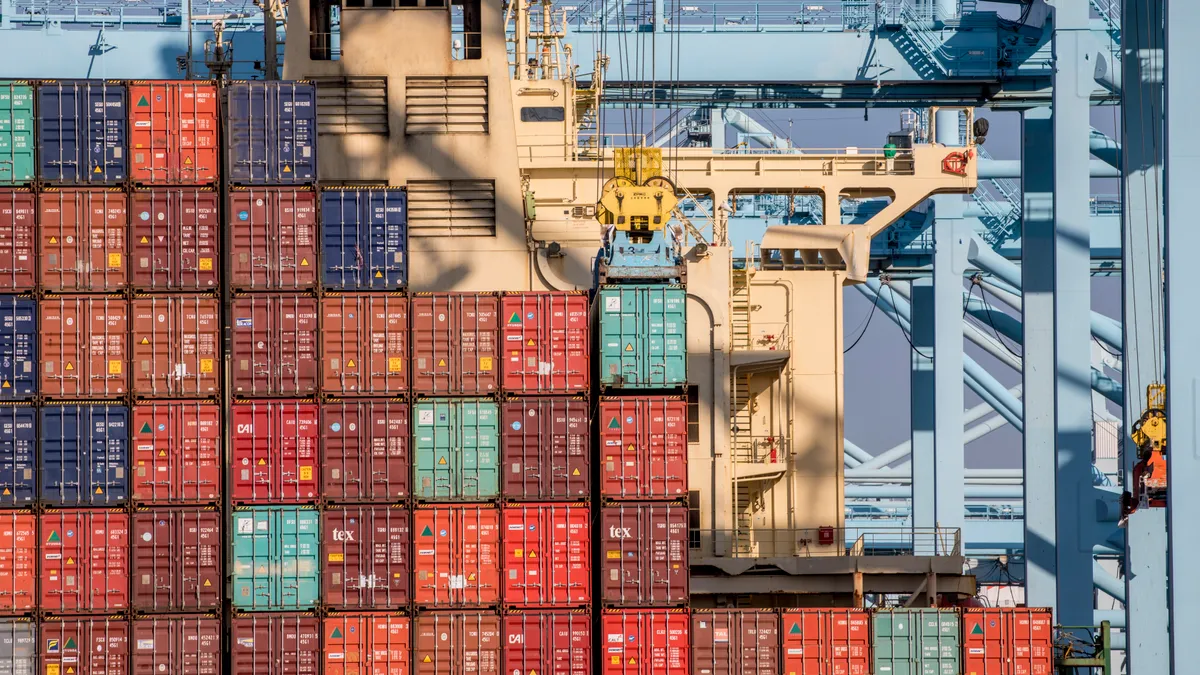Container ships and real estate deals don't move as fast a trade policy — at least not these days.
The vessels heading into West Coast ports with goods from Asia are coming into crowded shores. The Port of Los Angeles has been breaking its volume records for months, and April 2019 was the busiest April the port has seen in its 112 years of operation. Volumes reached 736,466 20-foot equivalent units (TEUs) — 4.5% higher than April 2018.
Storage space for these goods continues to wane as U.S. warehouse availability has been on the decline for 35 straight quarters, according to CBRE. Global Chief Economist Richard Barkham predicted a "a nicely balanced industrial sector, with demand and supply broadly in line" in mid-April when the U.S. trade war with China appeared to be rolling to a stop.
Less than a month later, President Trump tweeted negotiations with China were going too slowly, and the tariff rate on $200 billion in Chinese imports — known as tranche three — increased from 10% to 25% on May 10. Plus a new fourth list of goods to be tariffed is heading into a public comment period.
What will happen to warehouse space now, especially on the West Coast where U.S. imports from China most frequently make land? Kurt Strasmann, executive managing director at CBRE, said it all depends on how shippers perceive the current political climate. With negotiations being what they are, shippers must be vigilant of how rapid changes to the trade landscape may impact their ability to secure warehouse space.
A lot can happen in 90 days
Experts consulted for this report contend the recent escalation in trade tensions will not be met with panic. This early in the year, peak season is a still at a comfortable distance, but shippers can only wait and see for so long.
"If this tariff issue becomes a long-lasting ordeal — six to eight months — we do think it will obviously affect the flow of trade goods and will affect not just the Southern California marketplace, but nationally," Strasmann told Supply Chain Dive in an interview. "But if it’s a month — call it under 90 days — we really see no change whatsoever."
Strasmann attributed the 90-day grace period to a "big, deep, diverse market" in California. New warehouse construction in the golden state is rising to meet existing and growing demand. San Bernardino County, California, has 22.7 million square feet in new industrial construction projects underway and is the second-fastest growing industrial real estate market in the U.S., behind the Dallas/Fort Worth, Texas region, according to a quarterly review by the real estate company Lee & Associates.
Blake Shumate, chief operating officer for American Global Logistics (AGL), said tariffs or no tariffs, the state of the market for West Coast industrial real estate is still driving his clients to book space for 2020 now. The new construction, he told Supply Chain Dive in an interview, books up right away. His clients are frequently reserving space for product coming in 2020.
For more immediate needs, AGL’s customers are finding space in states slightly farther from the California ports like Utah.
"We don’t even know if we’ll need it, but if we’re going to want that space, we’re going to have to go after it now,” he said. Shumate indicated that at least for now, landlords have been resisting raising prices too high in favor or retaining customers, but if demand spikes, prices will almost certainly go up.
Tariffs can exacerbate a booming market, said Strasmann, but the healthy consumer economy is a more powerful driver when it comes to warehouse space.
Same market, faster pace
Retailers have been working on a just in time model for years now — trying not to hold any more inventory than is absolutely necessary to drive efficiency, boost margins and reduce reliance on additional industrial real estate.
Faster fulfillment commitments have led some retailers to stray from the model, though. 2-day shipping has been the standard definition of "fast" since Amazon Prime debuted in 2005, but last month, fast got faster when Amazon and then Walmart announced transitions to 1-day shipping.
Shumate suggested shippers may return to the just in time inventory model in this new tariff climate. The tranche four tariffs, should they go forward, will likely take effect in the summer — right when peak season merchandising plans are being finalized.
"It’s a little scary no doubt about it," said Strasmann, adding shippers may choose to bump up volume in a month or so if the trade tensions hold. "All of these customers have separate operating models. They’ll start taking precautions as we get closer [to peak]," he added.
Still, shippers are unlikely to stray away from is the West Coat Ports, according to Strasmann. "The economics still favor, for any type of high-quality product, to ship here. And still, half that product stays here," he said of the hungry California consumer market.






















